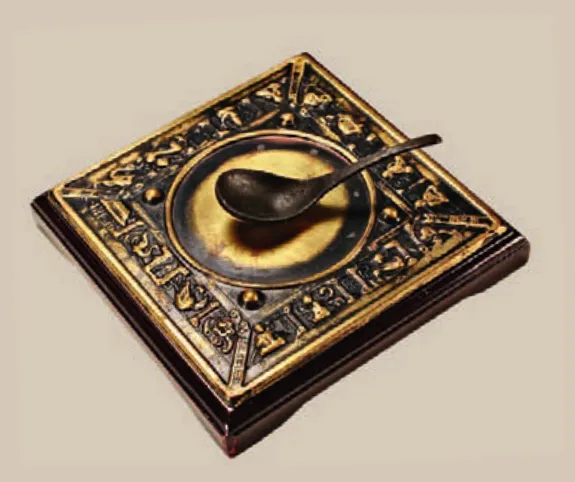The Compass
By GU HE
The Compass
By GU HE

T HAT China invented the compass is well known to all. The very first was known as a chariot compass, or “south-pointing chariot.” Legend has it that when the mythical Huangdi (Yellow Emperor) and tribal leader Chi You were at war, the former ordered his Minister Feng Hou to invent a chariot compass that would enable him to find his way through dense fog and defeat his foe.
Third century BC thinker Han Fei explained in one of his books the motivation for inventing the compass: “It was easy to get lost due to poor orientation, which is why kings in ancient times invented an instrument that points south and so shows in which direction West and East lie.” The instrument Han Fei mentioned is actually the chariot compass. No matter what direction the chariot turns, the arm of the wooden man it carries unfailingly points south as a matter of mechanical principle.
However, the principles of the southpointing chariot and compass are not the same. The compass works through its magnetized needle pointing to the Earth’s magnetic pole. China was the first country in the world to discover this phenomenon. Chinese ancients used this method during the Warring States period (475-221 BC) to invent the sinan, or compass spoon, considered ancestor of the contemporary compass.

Made of magnetite, the instrument is shaped like a spoon with a smooth underside that enables its rotation on a base where the four compass points are marked. When placed upon the base, the spoon handle points south. In the 1940s scientific historian Wang Zhenduo (1911-1992) created a model of the compass spoon based on this principle.
Progress from compass spoon to compass, however, was a long process. Making the transition from natural magnetite to artificially magnetized iron was the crucial step. The Chinese invented two ways of artificially magnetizing iron. The first, as today, was that of rubbing the needle against a magnet. Song Dynasty scientist Shen Kuo (1031-1095) described the technique in his book The Dream Pool Essays (Mengxi Bitan). The second entailed cutting a fish-shaped strip out of a metal sheet and using the geomagnetic field to magnetize it, so creating a south-pointing fish. But as manufacturing this type was complicated and inconvenient, the standard compass, still in use today, superseded it.
The compass brought about a navigational revolution, which is why it was of epochmaking significance. Its use in navigation began towards the end of the Northern Song Dynasty (960-1127), and promoted development of navigation in the Southern Song (1127-1279) and Yuan (1271-1368) dynasties. The compass enabled voyagers to draw navigation maps and nautical books, and was an indispensable instrument in Zheng He’s expeditionary voyages during the Ming Dynasty (1368-1644).
The Chinese navigational compass, however, was distinct in consisting of a needle floating in a bowl of water, which is why it was known as the water compass. Europeans later improved on it by placing the needle on a fixed support. It was thereafter referred to in Chinese as a “dry compass.”
During the Southern Song Dynasty, Arab and Persian traders often boarded Chinese ships heading back to China to do business. They so became acquainted with the compass, and brought about its entry to Europe, via Arab countries, in the second half of the 12th century. This generated new shipping routes.
The compass was thus literally instrumental to Christopher Columbus’ discovery of America and Magellan’s world circumnavigation, both of which marked turning points in European history. From that time onwards the whole world changed. Exploitation of America brought new knowledge and wealth to European countries, and the compass’ arrival in the West opened the floodgates of history, inundating medieval Europe in the general pursuit of capitalism.
Chinese inventions, including the compass, which spread to the West provided the material and technical foundation for Europe’s Renaissance. They also enabled the continent’s transformation from a feudal to capitalist society.
Karl Marx himself commented on the influence of the three Chinese inventions – gunpowder, the compass, and the printing press – on world history, and how they ushered in bourgeois society. Gunpowder eliminated the knightly class, the compass brought the founding of colonies and discovery of the world market, and the printing press became both a tool of Protestantism and regeneration of science in general. It was a powerful agent in the creation of intellectual prerequisites.
British philosopher Francis Bacon wrote in his Novum Organum: “Printing, gunpowder and the compass... have changed the whole face and state of things throughout the world, ... whence have followed innumerable changes, in so much that no empire, no sect, no star seems to have exerted greater power and influence in human affairs than these mechanical discoveries.”
Chinese ancients’ inventions, including the compass, therefore, are great scientific achievements of which the Chinese people should feel proud and for which people of the world should show admiration.
The article is selected from Monthly Digest, a magazine published by Zhonghua Book Company in Beijing.

